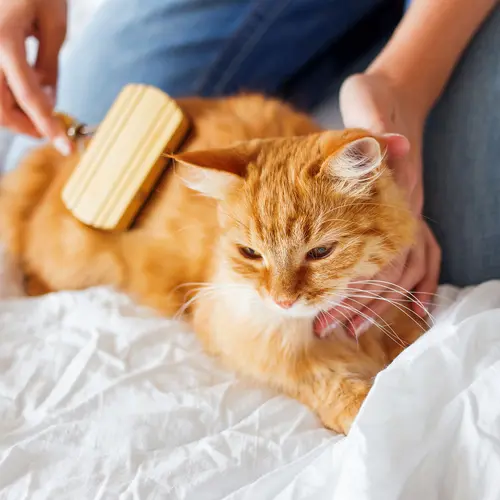Just like humans, cats can have mild to severe acne. Any cat can have feline acne (or cat acne), but this skin condition is more common in cats with skin folds or long hair. Here's what to know about feline acne.
What Is Cat Acne?
Because cat acne usually forms around the chin area, it is commonly called cat chin acne. Generally, it describes any inflammation on your cat's chin. This skin condition can appear as mild irritation or as painful, oozing swelling. Your cat may rub their chin if the acne is itchy, which can make the condition worse.
Most cases of cat acne are mild and usually pass unnoticed, but more severe cases are obvious and unsightly. Mild cat chin acne usually appears as tiny black spots or as a mild irritation on the chin. In contrast, severe cat chin acne usually appears as red sores and lesions. Severe cat chin acne may be tough to treat as it responds slowly to treatment.
What Causes Cat Acne?
In humans, oily skin is the primary cause of acne, but in cats, the exact cause is unknown. Usually, cat acne is related to the overproduction of keratin, a protein found in the skin. Cat acne may result when your cat’s hair follicles get blocked due to the overproduction of keratin. If the hair follicle traps excess keratin, blackheads will form. The blackheads (or comedones) become "pimples" (raise up, turn red, and may have some pus) if they get infected by bacteria.
Cat acne may also be caused by:
- Poor grooming
- Poor immune system
- Food allergies
- Contact allergies (such as plastic)
- Excessive keratin and sebum (oil) production
- The immune-barrier function of the skin
- Stress
- Hormone imbalances
What Is the Treatment for Cat Acne?
Treating feline acne requires that you understand the cause of the acne. Treatment involves removing excess sebum (oil), and preventing blackhead formation and secondary infection.
You can treat cat chin acne by using an antibacterial wash like chlorhexidine or dilute peroxide to clean your cat's chin. Apply the antibacterial wash with a cotton ball and clean the affected areas gently. You may worsen the irritation on inflamed skin if you don't do the cleaning gently. If the acne is mild, you may not need further treatment.
Your pet will need antibiotic therapy for severe acne with extensive secondary infection. Your vet may select the right antibiotics after doing sensitivity tests on the bacterial culture from the chin. Sometimes, fungal infections may also be involved. Your cat may also need to be on steroids or other topical medications such as retinoids for the short term to reduce the inflammation.
Your vet may prescribe topical preparations like mupirocin, shampoos, or wipes. However, topical treatment options may be challenging in cats because they will likely lick off whatever you put on their skin. If the acne outbreaks are helped by the topical products, you may reduce their use gradually over two to three weeks. If the acne recurs frequently, you may need a regular cleaning schedule as advised by your vet.
How Can Cat Acne Be Prevented?
You can reduce the chances of your cat getting cat chin acne. If you want to prevent cat acne under the chin, try to:
- Avoid plastic dishes and stick to glass or stainless steel water and food bowls.
- Clean your cat's chin after meals by wiping your cat's mouth with a clean towel or cloth.
- Clean your cat's food and water dishes regularly.
- Watch out for changes in their chin after introducing new items (new food, new chew-toy, etc.) into the environment. If you see acne, remove the newly introduced item for about a month and see if the condition gets better or resolves.
- Do not pick at your cat's acne, as it may worsen the condition and cause more pain and infection.
How Long Does Feline Acne Last?
Mild feline acne may disappear on its own. Treatment may be necessary otherwise, especially in severe cases. In extreme cases, your cat may have to be on antibiotics for four to six weeks.
Most pets will respond well to improved hygiene, and a change in food dishes and water bowls.

